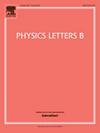The charge and magnetic radii of the nucleons from the generalized parton distributions
IF 4.3
2区 物理与天体物理
Q1 ASTRONOMY & ASTROPHYSICS
引用次数: 0
Abstract
The proton-radius puzzle refers to the discrepancy observed in measurements of the proton's charge radius when using different methods. This inconsistency has prompted extensive research and debate within the physics community, as it challenges the understanding of quantum electrodynamics and the fundamental properties of protons. In the present study, we determine the charge and magnetic radii of the proton and neutron through a global analysis of the generalized parton distributions (GPDs) at zero skewness. We emphasize the importance of a simultaneous analysis of all available experimental data related to nucleon radii, rather than relying on individual experiments, specific observables, or limited kinematic regions. This comprehensive approach ensures robust and consistent results, avoiding values that are either too small or too large. Our analysis yields the following results: , , , and .
求助全文
约1分钟内获得全文
求助全文
来源期刊

Physics Letters B
物理-物理:综合
CiteScore
9.10
自引率
6.80%
发文量
647
审稿时长
3 months
期刊介绍:
Physics Letters B ensures the rapid publication of important new results in particle physics, nuclear physics and cosmology. Specialized editors are responsible for contributions in experimental nuclear physics, theoretical nuclear physics, experimental high-energy physics, theoretical high-energy physics, and astrophysics.
 求助内容:
求助内容: 应助结果提醒方式:
应助结果提醒方式:


